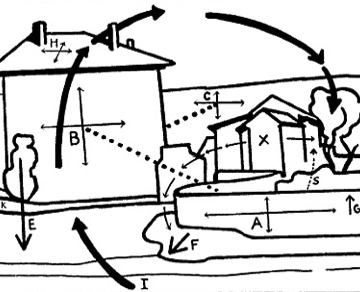The small door/window/ventilator into the studio was itself entered from an acrylic-roofed trellis that led to another house in the middle of the block, of wooden clapboard, and both like and unlike every other house in Cortland, New York: all white, inside and out, it held an amazing collection of modern artwork and furniture, of an eclecticism not unlike Seligmann’s architecture. When closed, the aperture signaled that the loggia was exclusively an entrance to this house, and that the volume of the studio building—destined to one day bow to real estate values and become a garage—would provide a private courtyard in the midst of the city. It is appropriate that, with all of its ambiguities and distinctiveness, formal and functional finesse, this compound was the home and office of architect/educator Werner Seligmann and his family.
And it is also appropriate that, rather than casually and headlong, it’s perhaps best to enter the works included here sideways, and with a thoughtful, lilting step over the threshold, as if through an aperture into a studio.
Coda: Symphonies of Apertures
The architecture/music analog has been overworked even while remaining indefinite and vague, and it’s generally been based on impressionistic or incomplete characterizations. At times, the relationship has been defined by differences—architecture and music aren’t considered to be as representationally inclined as the other arts; or by their outsider status—architecture and music are often identified as the two most autonomous of the arts, being more fully self-referential than externally referential. Both positions are debatable.
Of course, Wittkower and others have demonstrated proportional concepts as a basis for fundamental commonality: the length and subdivision of a string in generating notes and harmonious chords and the proportional dimensions of a rectangle or cube in providing a resonant harmony for the eye. Naturally, these notions of geometric proportion are potentially present in every visual art.
Time and again, though, I find myself returning to what seems to be an underlying musicality to Seligmann’s work. He was raised in a musical household, and he always seemed to have required the radio to provide a musical accompaniment whenever he worked; inevitably, it was 17th and 18th century classical music, and very rarely later than 1830.
Perhaps, more significantly, the musicality lies in the fact that, in Seligmann’s architecture, composition, as the organization of the parts of a whole most resembles the disposition of musical composition versus that of the composition of forms (that is, what was considered architectural theory in the traditional Beaux Arts curriculum). Whereas composition in most of the arts is used to reinforce the subject of a work or its emotional content or its principal motifs or the relationships of its parts to a whole, the notion of composition at work here seems to evoke distinctly baroque and late modernist concepts of perception, whereby the viewer (or listener) seems to be disallowed the traditional passive role of the distracted viewer.
Fig 14 Erle Loran, analysis of Cézanne’s Maison et ferme du Jas de Bouffan. The series of dark arrows, beginning at “I” trace the movement of the viewer’s eye as it inscribes increasing spatial depths before returning to the relatively stable frontality of the picture plane.

Introduction page 12